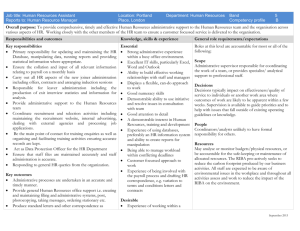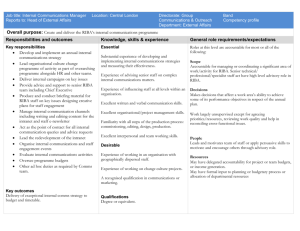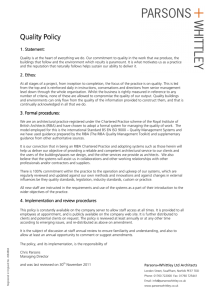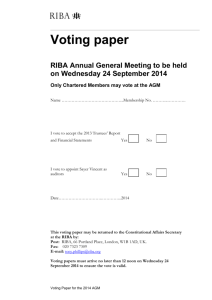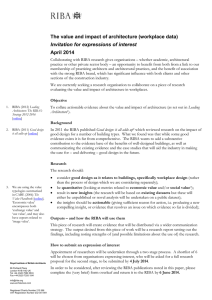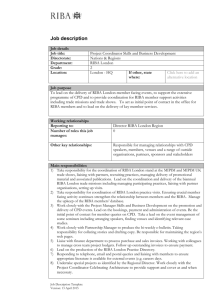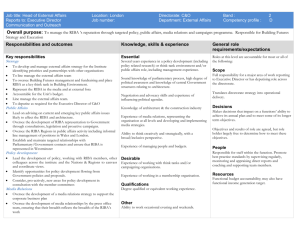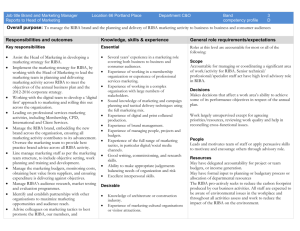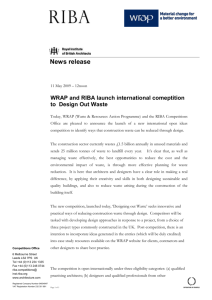For more information and advice on the selection Advisors please contact:
advertisement
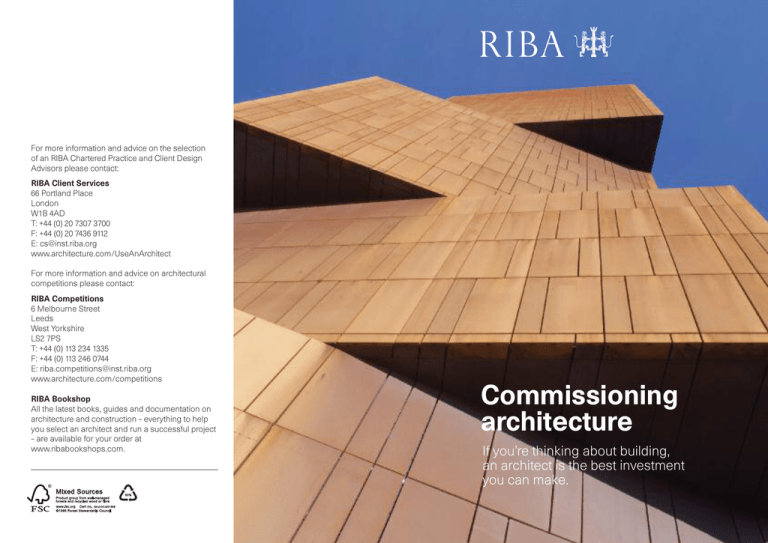
For more information and advice on the selection of an RIBA Chartered Practice and Client Design Advisors please contact: RIBA Client Services 66 Portland Place London W1B 4AD T: +44 (0) 20 7307 3700 F: +44 (0) 20 7436 9112 E: cs@inst.riba.org www.architecture.com/UseAnArchitect For more information and advice on architectural competitions please contact: RIBA Competitions 6 Melbourne Street Leeds West Yorkshire LS2 7PS T: +44 (0) 113 234 1335 F: +44 (0) 113 246 0744 E: riba.competitions@inst.riba.org www.architecture.com/competitions RIBA Bookshop All the latest books, guides and documentation on architecture and construction – everything to help you select an architect and run a successful project – are available for your order at www.ribabookshops.com. Commissioning architecture If you’re thinking about building, an architect is the best investment you can make. Whether you intend to construct a new building, expand your current facility, or adapt an existing structure, it makes sense to consult an RIBA Chartered Practice. This guide explains how to successfully select, appoint and work with an architect. CONTENTS 4 The value of an architect 6 The selection process 12 Appointing an architect 14 The design brief 15 Selecting a procurement route 16 RIBA Outline Plan of Work 18 Legislation Cover: Broadcasting Place, Leeds by Feilden Clegg Bradley Studios © Will Pryce RIBA Award 2010 Left: Wembley Stadium, London by Foster + Partners and Populous © Nigel Young / Foster + Partners RIBA Competition/RIBA Award 2008 2 3 The value of an architect An architect’s contribution to a building extends far beyond form and aesthetics. It can influence the perception, performance and add value to your business. Brought in early and given the opportunity to understand your business or organisation, an architect can design a building, a masterplan or interior that is tailored to your current and future needs, delivering architecture that is practical and functional but also a pleasure to work in and visit. Above: Paradise Street Footbridge, Liverpool by Wilkinson Eyre Architects © Tim Soar RIBA Award 2009 Below: Joseph Chamberlain College, by Nicholas Hare Architects LLP © Alan Williams Photography RIBA Award 2009 Consulting an architect at the earliest planning stages opens the door to cost savings, both in the construction and operation of the building, through innovative design solutions. Using an architect to manage your project and coordinate the work of consultants and contractors can save you time and money in the long run. A sound investment Good advice has its price but the cost of skimping on design quality is far higher. Design fees will usually constitute just a small fraction of the total construction expenditure and pale into insignificance when measured against the operating costs over the lifespan of a building. High quality design can reduce those operating costs by maximising the efficiency of the building. A building that has received the input of design professionals right from the start of the project could well end up being cheaper to run and command a greater value in the long term. A sound working relationship between you and your architect right from inception will contribute significantly to the success of the project. Time spent in preliminary discussion about the requirements, the timetable, the budget, and the nature and cost of professional resources required and their cost, is time well spent. 4 5 The selection process Choosing the right architect is a critical decision, proper time and consideration must be given to the selection process and to making the right choice that will lead to a good working relationship and ultimately an excellent design solution. All building projects are completely different, every client, every site and therefore every brief is unique. There is no single solution to your project and there is a whole range of architects able to offer their own approach. Selecting the right architect is one of the most significant decisions you can make – the RIBA can help you make this decision. The RIBA offers different services aimed at different clients: • Online directory of RIBA Chartered Practices • RIBA Client Services Referrals • RIBA Client Design Advisors • RIBA Competitions Online directory of RIBA Chartered Practices Our directory of over 3000 RIBA Chartered Practices has full contact details as well as project examples and images. Search by location, services offered and areas of expertise to quickly narrow down a list of likely practices. Links are provided directly to the practice website, where you can then make contact. Every one of the 3000 firms in the directory is an RIBA Chartered Practice, which means that it has met the RIBA’s world-leading standards of professional practice covering matters such as quality, customer service and insurance. RIBA Client Services Referrals If your project requirements are complex and your demands specific let RIBA Client Services search for you. The RIBA database holds information on more than 40,000 projects and we can quickly compile a unique shortlist of candidates with the right skills, experience and resources for your project. Register online at www.architecture.com/ UseAnArchitect/ and complete the form giving as much information as possible and we will come back to you with a shortlist. We can also contact them on your behalf, obtain profiles, request literature and provide guidance on appointing and working with your chosen architect. Above: Midland Hotel, Morecambe by Union North © Simon Webb RIBA Award 2009 Below: Maggie’s Cancer Caring Centre by Rogers Stirk Harbour + Partners © Richard Bryant/arcaid.co.uk RIBA Award 2009 By appointing an RIBA Chartered Practice you can be assured that they have been accredited in meeting key quality standards such as appropriate Professional Indemnity Insurance (PII), an effective quality management system, a comprehensive health and safety policy and a sound environmental policy. 6 7 RIBA Client Design Advisors Need a little more advice and a helpful point in the right direction? Talk to a Client Design Advisor (CDA) about what happens next, how to start thinking about the brief, what to expect from your architect and how to select one. CDAs are experienced construction professionals specially trained to maximise the quality and value of build projects. They have achieved accreditation from the RIBA and are able to provide vital independent advice that will help run your construction project efficiently and achieve best value and high design quality. A CDA can assist you from the earliest stage of a project. For more information about how a CDA can help your project start in the right direction call RIBA Client Services on 020 7307 3700 or email us at cs@inst.riba.org. RIBA Competitions There are many instances when clients require something a little different and a more rigorous approach to selection. The RIBA Competitions team can work alongside you to formulate a competitive process to fit your individual needs. Established for over 25 years, RIBA Competitions has an international reputation for organising selection processes that encourage excellence in design in architecture, landscape architecture, urban design and the public realm. Right: The Exchange, Penzance by MUMA © Ian Kingsworth RIBA Competition/RIBA Award 2008 8 9 Next Steps Research Once you have a shortlist you can begin gathering information about each practice to help make an informed decision. There are many sources available to help with this, such as visiting the company website, looking at their entry on the RIBA Online Directory (www.architecture.com/UseAnArchitect) to view examples of projects they previously worked on or listening to recommendations and contacting their previous clients to discover what they are like to work with. Interview the candidates You may choose a more structured selection process to make your decision between your requirements as a client and your architect’s skills and services. Meeting each of your favoured practices in an interview situation will give you an indication of whether the chemistry between you is right, which is extremely important when embarking on a new working relationship and for the ultimate success of a project. Some of the main issues to be discussed at interview are general design approach and ethos; introduction of key members of the team; past track record experience; working methods and practical resources. It is best to try to interview three to five practices so that you can gather enough information to gauge the range of different approaches on offer. Insist that the key personnel who will work on your project attends the interview and provide all practices with the same background information; site access and briefing material. Centre: Manchester Civil Justice Centre by Denton Corker Marshall © Daniel Hopkinson RIBA Competition/RIBA Award 2008 Right: Castleford Bridge by McDowell + Benedetti © Timothy Soar RIBA CABE Public Space Award 2009 10 What to look for The purpose of the interviews is to compare and evaluate your shortlisted architects’ different approaches. Look for the best balance between technical competence, professional service and, of course, design ability. Look for new ideas and a fresh outlook on the project. Find a good fit between your needs and the services offered. Do not underestimate the importance of empathy, and of finding an architect that shares your aims and expectations for the project. If you are still unsure about your final decision it may be worthwhile considering visiting one or two completed projects to see examples of past work first-hand. As soon as you’ve made your decision, inform all the practices included in the selection process. Be prepared to pay a fee or honorarium to any firms that you requested work from as part of the process. You may wish to use the support of the RIBA Competitions team to help you set up a Competitive Interview on your behalf in the first instance. 11 Appointing an architect Fees and expenses A good working relationship between an architect and client is crucial to the success of any building project. You and your chosen architect should discuss and agree on the scope and cost of architectural services before the project is started and ensure the agreement is in writing. There is no standard or recommended basis for calculating the fee and it is usually a matter for negotiation. The fee will reflect the scope of services and bespoke design that your project involves. Other factors will include the complexity of the project, practice’s reputation, the scope of services provided, construction cost and project timescale. RIBA Appointment Contracts are flexible documents that can be tailored to cover a wide range of project types and procurement paths, from restorations to new builds, from design-and-build to management contracting. They include a Memorandum of Agreement or contractual letter, a Schedule of Services and a Schedule of Fees. If you make modifications to the standard agreement, have them checked by your legal advisor. Fee options The basic fee options for normal services where the architect is involved in the project between the Concept stage and final inspections may be: • Quoted percentage of the final build cost or • Lump sum or • Time charges (could also be suitable for other services) or • Another agreed basis, for example value added fees based on the increased value of a site or building, exceeding performance targets and so on. For clients embarking on a small build project the RIBA publishes two forms of agreement: • Concise Agreement – suitable for a professional commission or construction project with simple contract terms, and normally used where the client is acting for business or commercial purposes • Domestic Project Agreement – suitable for use where the client requires work to his/her home. For clients commissioning larger projects, the RIBA publishes: • Standard Agreement – suitable for any professional commission or project where detailed contract terms are necessary. It can apply to most procurement methods, including design and build. For your part, the client should be prepared to: • advise on the relative priorities of requirements and to provide necessary and accurate information • take decisions and respond promptly to questions asked by your architect • pay the fees, expenses and disbursements due and VAT where applicable. All the agreements can be obtained from the RIBA Bookshop at www.ribabookshops.com. 12 An architect may often quote their fee as a percentage of the building cost or as a lump sum. In cases where the scope of their work is harder to predict, or for services such as surveys or party wall advice, the quote will usually consist of an hourly or daily rate together with an estimate of the time required. Above: Clapham Manor Primary School by de Rijke Marsh Morgan © Jonas Lence RIBA Award 2010 Below: 60 Threadneedle Street by Eric Parry Architects for Hammerson © Tim Soar RIBA Award 2010 Expenses These will generally be added to the fee and will be charged for items such as the costs of travel, copying drawings and documents, and for making planning or Building Regulations applications. Payment An architect who is retained for the entire project will typically invoice about one third of the fee during the design stage, the same at the tender stage, and the balance during and following construction. Variable invoices may be issued on a monthly basis, or regular payments can be budgeted over a period. 13 The design brief Selecting a procurement route The quality of your finished building will reflect the quality of your brief. A well-written design brief is fundamental to success. It should be clear and unambiguous, setting out key requirements, outlining the vision and communicating your aims and aspirations. There are several different types of procurement routes available to clients. Each type of procurement route (traditional, construction management, design and build etc) has its own strengths and weaknesses. The brief should describe the main function of the finished project; outline motivation and expectations; design direction; establish a single point of contact and set a realistic timeframe and budget. A good brief acts as a map to help the project delivery team reach their destination. An architect is crucial in helping formulate the brief. The process will involve a number of discussions and help establish the dialogue between you that is essential for the project. A good, thorough brief will form the basis of the professional agreement you sign with your architect. You may still be uncertain about some of these issues, in which case your architect may be able to carry out some preliminary research or feasibility studies that will help you firm up your requirements. For a major project you may wish to appoint an RIBA Client Design Advisor to advise you on brief development, design options, design team appointment and evaluating alternative procurement routes. The RIBA is committed to construction procurement that: • provides the best value to the commissioning client, present users, future users, the public and society in general • provides for the process to be clear, collaborative and creative • provides for an appropriate balance of economic, social and environmental factors • provides for an appropriate balance of conservation and innovation • results in a better designed environment. The key decisions in any building process will be made at a very early stage in the project's life, during and even before the briefing/feasibility work has been carried out. These will have an important impact on the successful outcome of the project and the full range of alternative ways forward need to be given active consideration before embarking on a project. Matters for consideration 1. Outcomes 2. Scope and Brief 3. Building the Team 4. Procuring the Building 5. Completion Centre: The Yellow Building by Allford Hall Monaghan Morris © Tim Soar RIBA Award 2009 14 15 The RIBA Outline Plan of Work 2007 (amended November 2008) The RIBA Outline Plan of Work organises the process of managing, designing building projects and administering building contracts into a number of convenient work stages, A-L. Architect’s services and fees are usually based on these stages. DESIGN C D E Concept Implementation of a design brief and input to the project brief. Preparation of a concept design including outline proposals for structural and building services systems, outline spcefications and preliminary cost plan. Review of procurement route. Design development Preparation of a developed design to include structural and building services systems, updated outline specification and cost plan. Completion of the project brief. Application for detailed planning permission. Technical Design Preparation of technical design(s) and specifications, sufficient to co-ordinate components and elements of the project and information for statutory standards and construction safety. PRE-CONSTRUCTION Design brief Development of the client’s initial statement of requirements into the design brief by or on behalf of the client confirming key requirements and constraints. Identification of procurement method, procedures, organisational structure and range of consultants and others to be engaged for the project. G H J CONSTRUCTION B Appraisal Identification of client’s needs and objectives, business case and possible constraints on development. Preparation of feasibility studies and assessment of options to enable the client’s to decide whether to proceed. K L USE PREPARATION A F Production information F1 Preparation of production information in sufficient detail to enable a tender or tenders to be obtained. Application for statutory approvals. F2 Preparation of further information for construction required under the building contract Tender documentation Preparation and/or colation of tender documentation in sufficient detail to enable a tender or tenders to be obtained for the project. Tender action Identification and evaluation of potential contractors and/or specialists for the project. Obtaining and appraising tenders; submission of recommendations to the client. Mobilisation Letting the building contract, appointing the contractor. Issuing of information to the contractor. Arranging site handover to the contractor. Construction to practical completion Administration of the building contract to practical completion. Provision to the contractor of further information as and when reasonably required. Review of information provided by contractors and specialists. Post-practical completion L1 Administration of the building contract after practical completion and making final inspections. L2 Assisting building user during initial occupation period. L3 Post-occupation evaluation: review of project performance in use. For more information and details about the RIBA Outline Plan of Work please visit the RIBA’s website at www.architecture.com. The Plan in full, including work stages by differing procurement methods, can also be obtained from RIBA Bookshops (www.ribabookshops.com). 16 17 Being a good client It is vital to find the right architect to work with. However, to be a success, your project will need the right kind of client too. The project will need to be properly resourced and managed at your end as well as by the architect. It may be necessary to appoint a committee of carefully chosen people to share decision making and review responsibilities. These might include areas such as planning, scheduling, budgeting, fundraising and cost control. Make sure that one person becomes the designated point of contact with the architect. They should carry authority as your representative at planning sessions and project meetings. Factors for success For further reading the RIBA recommends: Legislation It is important before you start your project that you are aware of the approvals that will be needed from the local authority for Planning and for Building Regulations approval, as well as legislation that affects your project, such as party wall regulations, Construction (Design and Management) Regulations 2007 (CDM), Site Waste Management Plans Regulations 2008 and Disability Discrimination Acts 1995 and 2005. • ‘A client’s guide to engaging an architect’ (November 2009 revision) for further information for all construction clients this guide offers a quick and easy overview of the value, mechanisms and context of appointing an architect • ‘A client’s guide to health and safety for a construction project’ which outlines the impact on clients of the Construction (Design and Management) Regulations 2007 • ‘Guidance for clients on Party Wall Matters’. Your architect can guide you through matters as they develop the design. They will also be able to assist you in making the necessary submission for approvals and handle negotiations with the statutory bodies. The building contract This is a vital document – the legally binding commitment between your builder and you as the client to deliver your project. Your architect can administer this contract on your behalf. It is not uncommon for building projects to contain hidden surprises – structural quirks or unexpected ground conditions, for example – that can have an impact on the design and the building cost. The best way of preparing yourself is an adequate written contract, designed to manage such events fairly from each party’s point of view. 18 All available from RIBA Bookshops (www.ribabookshops.com). Above: Carrasco International Airport, Uruguay by Rafael Vinoly Architects © Daniela MacAdden RIBA International Award 2010 Below: Wexford Opera House by Keith Williams Architects with the Office of Public Works in Ireland © Ros Kavanagh RIBA Award 2009 ‘Creating excellent buildings: A Guide for Clients’ published by CABE (Commission for Architecture and the Built Environment) is available to download from www.cabe.org.uk/publications free of charge. The guide identifies the key skills and attributes shared by clients on successful projects. 19
